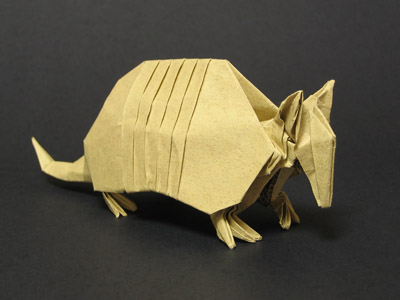The annual Origami USA convention is coming up in just two weeks, and I’m working on to make some new models for my exhibit this year. Each year I have a few new things and keep some favorites from the years before. Last year the new stuff was Origami From Space, which I will blog about at some point because I’m not done with that line of investigation just yet. More than just a thematic idea, there’s a whole approach to folding in there that I haven’t seen developed elsewhere, and I think is worth pursuing. This year I have a bunch of rather various stuff, including polyhedra, insects and animals. There’s my Butterfly and my Stellated Rhombic Dodecahedron, and now, a brand new Armadillo. I have a bunch more models in the queue, pulling together some threads I’ve been working on for a long time.
I’ve been working on the Armadillo off and on for the better part of a year. Tonight I completed a final version, which I made out of nice paper and it came out really well. The model uses my hex base, which is great for four-legged animals with balanced head and tail, approximately equally long legs, and of course toes. I made a pretty good first attempt a few months ago. The shell and body looked great and the tail and overall proportions were pretty good, and certainly the concept was working. There are some pretty interesting symmetries in the there that I used to develop the shell. The head and neck turnout out to be really tough to get just right. So much of a subject’s identity and attitude is in the head and neck. It seems like I’ll spend as much time on this as the rest of the model. I’ve even made head studies — models of just the head of a subject before. This one in particular had to have big ears and eyebrow ridges in addition to the usual proper posture and pose . The ears were a challenge since the base did not have extra points to use for the purpose, so they basically had to come from nowhere, and it was hard to pull that off and still have an okay looking head. So I’m really pretty happy with the way this one turned out, and it’ll be a keeper in this year’s exhibit fer sure.
I’m tempted to name this model Tarkus, in honor of the classic Emerson Lake and Palmer album with an armored armadillo on the cover. The it would also qualify for membership in the mythical creatures category.
Next up, I have a work-in-progress Ladybug that uses the same base as my Butterfly. It features a black body with a red carapace with 2 black spots, so the double color change is the major interesting thing about it.
Another idea I have is a Dual Tetrahedron. This shape, composed of two intersecting tetrahedra, is equivalent to a stellated octahedron, except that the two tetrahedra would be different colors. I’ve made versions of this shape before out of 4 and 2 sheets of paper, but the single-sheet version is obviously the one to go for.
Third, I want to fold a plant, for this year’s convention challenge. I have an idea for a potted plant, but since the devil is always in the details, I won’t know for sure if it’s a good idea until I have it folded. I have yet to even make a serious attempt yet.
If I get that far, it’s on to the bonus round. An idea I’ve been carrying around for a while for an Oliphaunt. These mythical creatures were featured in the Lord of the Rings films, visualized not just as extra-large elephants, but also having four tusks. The approach I would use would be take my Elephant and modify the base. The side effect of generating more points for the extra tusks would be to have extra paper in the middle of the model. I’ll use this to make a castle on the beast’s back. I figure it’ll make a nice complement to my Dragon.
We’ll see how far I get down this list. The good news is, even though I probably won’t get all of these models made, when I get to the convention, it’s always a really productive and creative folding environment, and I’m sure to make progress as well as come up with some new ideas.
